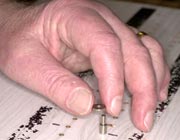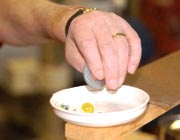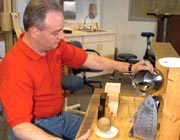Two U.S. hand transplant patients steadily gaining function
The first one has localized touch at the tips of most fingers and grip strength of 15 lb. on a dynamometer.
Click Here to Manage Email Alerts
![American Society for Surgery of the Hand 59th Annual Meeting [logo]](/~/media/images/news/print/orthopedics-today/2004/10_october/asshbutton_109_100_1731.gif) The
surgeon who led the first hand transplant on a U.S. patient approximately 69
months ago reported that the patient’s hand function is good. The patient,
Matthew Scott, is the longest surviving hand transplant patient in the world.
The
surgeon who led the first hand transplant on a U.S. patient approximately 69
months ago reported that the patient’s hand function is good. The patient,
Matthew Scott, is the longest surviving hand transplant patient in the world.
Since September 1998, 24 hands have been transplanted onto 18 patients living in six continents.
Warren C. Breidenbach, MD, FRCS, a hand surgeon with Kleinert, Kutz and Associates Hand Care Center in Louisville, Ky., reported the functional results of Scott’s transplant and that of the second U.S. hand transplant patient at the American Society for Surgery of the Hand 59th Annual Meeting in New York.
At 48 months postop, motor function had returned to Scott’s transplanted intrinsics. The Carroll test score for his left transplanted hand was 63 out of a possible 99 points at five years postop compared to 61 points at three years postop.
During his presentation, Breidenbach showed a dramatic videotape of Scott demonstrating his hand function.
Caution still needed
Results of a recent Carroll test done in the second transplant patient, who just reached three years postop, was 51 points. That patient’s three-year test has not yet been performed, but Breidenbach described his progress as being at “about where the first patient was at two years … This exceeds that which is seen with a prosthesis.”
Carroll test scores with prostheses can range from 20 points to a maximum of 25 points, he said.
But, Breidenbach was quick to point out that careful attention must be paid to immunosuppression in these patients, as well as to possible complications and problems.
“We’ve had a 100% one- and two-year survival overall, 92% allograft survival worldwide, which represents the best rate of any first time transplant with no mortalities and no infections,” Breidenbach said.
Combating rejection
Scott, who still does physical therapy once every two weeks, has attained localized touch on the tips of four of his fingers, but his index finger is correct for touch only half the time. “He can do both gross grip and fine. Activities of daily living are well within his norm and actually a nontrained [person] — someone who’s not a hand surgeon — wouldn’t notice that his function is less than optimal.”
Worldwide, all of the patients who underwent hand transplantation have received low-level immunosuppression drugs comparable to that kidney transplant patient take. No cases of graft vs. host disease were reported.
“We’ve been able to control rejection and maintain function; however, this is not to say there are not complications. Two hands have been lost, hyperglycemia has been a problem in six patients and there have been opportunistic infections which were easily controlled and that included avascular necrosis of the hip,” Breidenbach said.
As far as the two U.S. patients are concerned, Scott had three rejection episodes within the first six months of surgery but has not had any others. He has also had to battle cytomegalovirus (CMV) conversion because he was CMV negative and the donated hand was positive.
 |
 |
 |
|
| At four years (left) and five
years postop (center and right), Matthew Scott demonstrates the use of his
transplanted hand. Scott, who does physical therapy once every two weeks, has
attained localized touch on the tips of four fingers.
COURTESY OF JEWISH HOSPITAL;
KLEINERT, KUTZ AND ASSOCIATES HAND CARE CENTER; | |||
Second complication
The second U.S. patient had the most significant complications: diabetes and avascular necrosis of the hip. The latter was likely a consequence of the steroids he took in conjunction with immunosuppression drugs, but he successfully underwent core decompression surgery without discontinuing his immunosuppression course. In addition, he developed rashes when his body rejected the transplanted skin.
During the discussion period, Breidenbach said no additional transplants have been done in the last year and predicted future enrollment would be low due to the risks of infection and issues surrounding use of immunosuppression. “We’re going to see more patients done, but I don’t think it’ll be at any faster rate than it has been for the last five years.”
For more information:
- Breidenbach WC, Gonzalez R, Pidwell D, Gorantla VS. Functional results in the two American hand transplant patients. 10B. Presented at the American Society for Surgery of the Hand 59th Annual Meeting. Sept. 9-11, 2004. New York.
